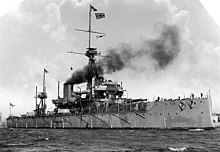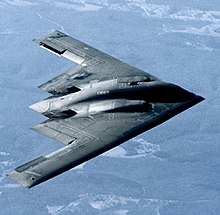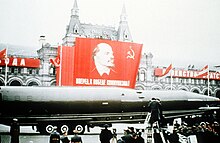arms race
Under arms race or arms race means the stages taking place military upgrade to antagonize opposing states or alliances . It is a sub-process of armaments dynamics . Well-known arms races took place between the German Reich and the Triple Entente (see also: German-British Naval Competition ) before the First World War and between the two western and eastern power blocs during the Cold War .
The International Relations conceive an arms race as a variant of the security dilemma and operate at its exploration game theoretical insights. An arms race is similar to the prisoner's dilemma .
The arms control is intended to prevent or mitigate an arms race. Examples of this are contracts such as START or SORT .
Arms Races in History
German-British naval competition
The naval laws of the Admiral von Tirpitz in the German Empire under Kaiser Wilhelm II led to an arms race with Great Britain and are considered to be one of the causes of the First World War .
The British Naval Doctrine was the so-called two-power standard , which required that the Royal Navy must always be at least as strong as the two subsequent fleets combined. The 2nd Fleet Act (passed in June 1900), which provided for a significant increase in the German fleet, was seen as the start of the arms race . At the same time, the construction of the British ship HMS Dreadnought falls in 1905, which is seen as the type ship for a new generation of capital ships , the Dreadnoughts , which was superior to all previous types and devalued them. So both navies had to start over and this gave Germany the chance to keep up with armaments.
In the "Cold War"
Soon after the end of the Second World War , under the sign of the "Cold War", the system confrontation between West and East , an arms race between the USA and NATO, founded in 1949, began on the one hand and the Soviet Union and the Eastern Bloc on the other, leading to self-dissolution of the Warsaw Pact lasted in the early 1990s.
In the early 1950s - the time of the Korean War - the arms race between East and West increased in scope (number of participating states) and speed. Almost all industrialized countries in the world were involved. Technological innovations quickly made existing armaments - for example aircraft - obsolete. All of this led to a cost explosion and the biggest wave of armaments in history to date.
In the conventional armed forces, innovations such as full motorization and armoring of the troops, the widespread introduction of rocket weapons and jet aircraft , in the navy the introduction of nuclear-powered ships etc. were characteristic.
Despite the accumulation of huge stocks of spectacularly new weapon categories in the decades that followed - in addition to nuclear weapons , chemical and biological weapons - the conventional armies continued to be by far the largest cost factor in overall armaments expenditure. Technologically, the Western alliance, and especially the United States, maintained a lead over the Soviet Union for almost the entire arms race in the Cold War. Probably the most notable exception to this was the first development of a functional ICBM by the Soviet Union - the so-called Sputnik shock of 1957. For example, in 1960 the Soviet Union put the R-7 , a further development of the Sputnik launch vehicle , into operation as the world's first ICBM. In the area of weapons of mass destruction , the number and explosive power of nuclear weapons were initially increased. The first two US atomic bombs used in August 1945, with an explosive force of 20 kilotons of TNT, were enough to kill several hundred thousand people. From the early 1960s, there were hydrogen bombs with around 20 megatons of explosive power. One of them would have been enough to cremate a big city.
During the Cuban Missile Crisis in 1962 , the United States and the Soviet Union, led by John F. Kennedy and Nikita Khrushchev, were on the verge of war. For the first time, a real awareness of the problem began to develop that there could be a nuclear war . The result of this was the nuclear test ban treaty signed in 1963 .
Soon the arms race concentrated on perfecting the delivery systems and their accuracy. The increase in explosive power, as it was expressed in the extreme in the Soviet so-called Tsar bomb , which was soon recognized as nonsensical from a military point of view, was abandoned . Long-range bombers , which could still be intercepted by air defense , were supplemented by ICBMs , for which there is still no means of defense. This arms race conjured up the possibility that both sides could theoretically destroy not only the enemy ( mutual assured destruction ) , but the whole world several times (see “ Overkill ”).
In view of the fact that the clear strategic superiority of the US / NATO in terms of nuclear strategy, which had only recently existed, was fading and soon ceased to exist since the early 1960s due to massive Soviet armament, the principle that every attack is answered with the complete destruction of the attacker was abandoned should be (so-called massive retribution ). As a result, the western alliance developed the principle of flexible response , which was adopted in 1967 as the official NATO doctrine. The aim was to react more flexibly to an attack than before (e.g. only resort to tactical nuclear weapons when conventional forces are no longer sufficient) in order to avoid a comprehensive strategic all-out exchange of blows if possible. Even if the feasibility of these ideas was often questioned, conventional armaments and traditional land warfare were generally accorded significantly increased importance in West and East since the early 1960s.
Compared to the USA and NATO, civil defense was much more important in the sphere of influence of the Soviet Union. More shelters were built and huge bunker systems were created, especially for the leadership of the party and the military . In contrast to the USA (which significantly dismantled its defense systems from the 1960s), air defense was also much more extensive with thousands of anti-aircraft missile positions and interceptors as well as the ABM .
In 1972 the ABM and SALT agreements formed the first basis to at least stop the expansion of the nuclear delivery systems. However, the SALT and the ABM Treaty (May 1972) could not prevent the further growth and perfecting of the strategic arsenals ; since the early 1970s, both sides introduced multiple nuclear warheads ; In total, both sides had around 10,000 strategic warheads each in the 1980s. The “raw power” was increasingly being replaced by more and more sophisticated technologies. In addition, the spectrum included spy satellites and camouflage technologies . Furthermore, new tactical nuclear weapons were invented and in some cases also developed, for example the so-called backpack bomb (a portable nuclear weapon with a relatively low explosive power). A project that was soon no longer pursued was the neutron bomb , which was intended to kill living targets (people) in particular through released neutron radiation and to keep the infrastructure of the target area as intact as possible. The destructive power of conventional weapon systems was so increased that it came close to that of small nuclear weapons.
The usual justification for the arms race or the arms spiral consisted of the assertion that the own side had to continue to arm, since the other side did the same and was striving for superiority. Ronald Reagan ran the arms race with the declared aim of bringing the communist bloc to its knees economically. His announcement of the SDI project in 1983, behind which the objective of a strategic invulnerability of the USA against possible Soviet attacks, was clearly recognizable. In a bloc confrontation, which had already intensified again since 1979 as a result of the Afghan war and NATO double resolution, the desired excessive demands on the Eastern leading power and its satellite states gradually became apparent.
With the end of the Cold War, the arms race between NATO and the Warsaw Pact or the USA and the USSR also ended.
Arms race today
Today there is only a high-tech defensive arms race between the United States and what they call “ rogue states ” without the term arms race being used any more. It is postulated that even an underdeveloped country with few intercontinental weapons of mass destruction can effectively threaten a highly developed country. On the one hand, attempts are now being made to prevent this threat in the approach by imposing controls on these states with regard to the manufacture of NBC weapons . In addition, the USA is trying to develop defense systems that can destroy weapons that can be used intercontinentally on approach.
Greece and Turkey
For decades, Greece and Turkey have been embroiled in a costly arms race in which Greece in particular has been burdening itself with new debts. The two states were last on the brink of war in 1995 , which rekindled the armament efforts of the militarily inferior Greeks. In 1999 a dialogue began with Greece hoping to end this arms race. For the same reason, Greece also supports Turkey's EU candidacy . A Turkey integrated into Europe would (according to the calculation) be a peaceful neighbor. When these hopes were dashed, Greece began negotiations with arms suppliers in order to u. a. to buy six frigates , 17 helicopters (estimated costs including armament: around 3.7 billion euros) and five reconnaissance aircraft for the Navy (250 million euros). Athens also negotiated the delivery of 415 armored personnel carriers with Russia . Greece spent 3 to 6.4% of its gross national product on armaments annually, Turkey over 5%, for comparison Germany 1.5%, Switzerland 1%, Austria 0.9%. Even the Greek financial crisis did not lead to a downsizing of the army (so far about 130,000 men) or disarmament measures for military equipment and the “wish list” remained.
Pacific
China is in dispute with several neighbors over territorial claims and raw material deposits in sea areas.
China has massively increased its arms spending, especially in 2009 and 2010. The financial and economic crisis of 2008 and 2009 shook the United States' claim to power ; China, on the other hand, has emerged stronger from the crisis.
The then US Secretary of Defense Robert Gates rejected fears about a direct comparison of forces with the Chinese. "We should not worry so much that they could challenge the US symmetrically, plane by plane, ship by ship, but that they acquire the ability to restrict our freedom of movement and our strategic options." It seems clear that expansion and modernization of the Navy and Air Force have an overriding strategic goal, namely access denial : China wants to be able to deny the USA access to the sea areas off its coast. China has an airworthy J-20 stealth bomber , the Dongfeng 21D ballistic anti-ship missile and the Liaoning aircraft carrier, which entered service on September 25, 2012 .
During the Taiwan conflict 1995/1996 sent the US two aircraft carriers - associations in the Taiwan Strait to China from attacking Taiwan hold; many observers assume that China will one day conquer Taiwan. China is unofficially pursuing core national interests in the South China Sea. After China's "Century of Humiliations", which goes back to the Opium Wars in the middle of the 19th century and the forced opening of the country by European imperialism, and which China's collective memory is still aware of today, "they can boil up the people's soul at the slightest occasion ".
At a meeting of the Foreign Ministers of the Asean Regional Forum (ARF) in Hanoi in July 2010, Hillary Clinton offered American mediation in the territorial dispute. This led to an outburst of anger among the Chinese foreign minister. He warned the states of Southeast Asia against cooperating with foreign powers in resolving territorial conflicts. The Southeast Asians seek proximity to the United States. Countries such as Thailand , Singapore , Indonesia and the Philippines are today intensifying their traditionally close ties with Washington. Amazingly, Vietnam is now also leaning towards America and doing joint maneuvers with the former enemy. The American warships are even allowed to call at the Cam Ranh Bay naval base again .
The conflict between North and South Korea (see also North Korea Crisis 2013 ) is also fueling the arms race in the Pacific.
The SIPRI published in 2013 statistical data for the period 2008 to 2012. 74% of China's arms sales went to countries in Asia and Oceania. 55% of China's arms exports went to Pakistan . China supports Pakistan in the arms race with its neighbor India . There have been tensions between the two countries (see Kashmir conflict ) since they emerged from British India in August 1947 ( partition of India ). In addition to economic interests, the Chinese also have solid strategic interests in Pakistan.
See also
- Cold War Treaties and Conventions
- disarmament
- Permanent arms industry
- Military-industrial complex
- Aggressive war
literature
- Richard J. Barnet: The American Armaments Mania. Rowohlt, Reinbek 1984, ISBN 3-499-11450-X .
- Jürgen Bruhn: The Cold War or: The dead armor of the Soviet Union. Focus, Giessen 1995, ISBN 3-88349-434-8 .
- Dieter S. Lutz (ed.): The armament of the Soviet Union: armament dynamics and bureaucratic structures. Nomos, Baden-Baden 1979, ISBN 3-7890-0482-0 .
- Erwin Müller: Armaments Policy and Arms Dynamics: Case USA. Nomos, Baden-Baden 1985, ISBN 3-7890-1076-6 .
- Ray Perkins: The ABCs of the Soviet-American Nuclear Arms Race , Brooks / Cole Publishing Company, Pacific Grove California, USA 1991, ISBN 0-534-14526-4 .
Web links
Individual evidence
- ↑ With the "storm" against America. In: Katapult , July 13, 2015
- ↑ Greece is arming - against Turkey. In: Der Tagesspiegel , January 28, 2009
- ↑ Stable euro or expensive Eurofighters. In: Handelsblatt , March 8, 2010, (PDF; 67 kB) (from the press review of the Italian Ministry of Finance)
- ↑ The Hypocrisy of the Arms Dealer. In: Die Zeit , March 16, 2010
- ↑ Sebastian Barzel: Military expenditure as a percentage of the gross national product (GNP). SeBaWorld, Berlin, accessed on March 1, 2010 (Google Cache)
- ↑ Claas Tatje: Nice weapons for Athens. - Frigates, tanks and submarines: Any austerity package bypasses Greece's military. And Germany benefits from it. In: zeit.de , January 7, 2012
- ↑ a b c d e f USA are concerned about China's new military force. - The Pentagon is concerned: China is accelerating the modernization of the armed forces. Cyber warfare will be expanded and US supremacy will be reduced. In: zeit.de , August 17, 2010
- ↑ First aircraft carrier strengthens China's navy. Retrieved September 25, 2012 .
- ↑ China moves up to the top arms dealers. In: spiegel.de , March 18, 2013




